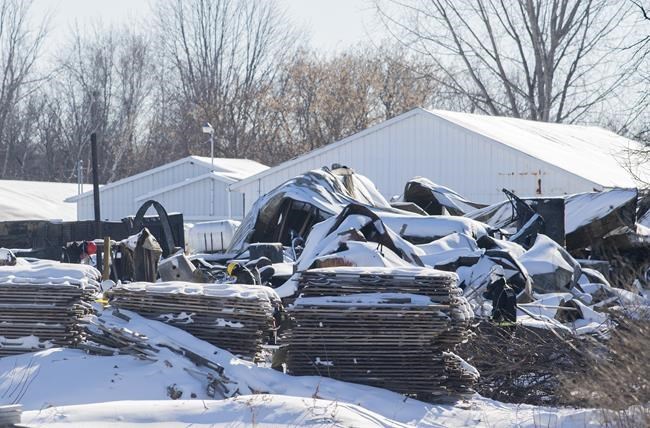MONTREAL — The investigation into the causes of a fatal blast at a propane company north of Montreal could be long and complex, police said Tuesday after three bodies were found at the site.
Officials are dealing with a "vast" scene complicated by snow, hazardous materials and objects that were projected far from the scene, provincial police spokeswoman Éloïse Cossette said.
"It’s a very large scene with piles of debris, so we need to be very careful," Cossette said.
Police announced late Monday they had found the remains of three people missing since last Thursday's explosion at Propane Lafortune, in St-Roch-de-l'Achigan, Que., about 50 kilometres north of Montreal. The remains are believed to belong to workers associated with the company, and they have been taken to a lab to be formally identified.
The local fire department received calls Thursday morning about an explosion and fire at Propane Lafortune, but the risk of further explosions forced firefighters to retreat. They were only able to bring the blaze under control in the evening.
The propane company later said the missing people included two employees and a subcontractor.
Five days after the explosion, investigators were "still looking for answers" about what caused the blast, Cossette said. She said there were several types of fuel at the scene, including propane, gasoline, diesel and heating oil.
Searchers had to shovel snow from the scene before they could sift through piles of debris, Cossette said, adding that the force of the blast scattered evidence far away and burned some of it.
"It's long-term, meticulous work," she said.
The police major crimes unit has also been conducting an off-site investigation that includes speaking with a number of witnesses. Cossette declined to say if police suspect any crimes had been committed, but she said the investigation includes taking legal steps, such as obtaining warrants.
Gregory Patience, a professor of chemical engineering at Polytechnique Montréal, says such explosions are very rare in Canada, though not unheard of. As examples, he referenced a natural gas explosion in Mississauga, Ont., that damaged dozens of homes in 2016, as well as the Lac-Mégantic rail disaster of 2013, in which 47 people were killed when an oil-laden train derailed and exploded in the downtown core.
For an explosion to occur, he said, it takes three things: fuel, oxidation (generally air), and an ignition source to set it off, such as a spark, cigarette, or even static electricity.
While he said he doesn't know the specifics of what happened in St-Roch-de-l'Achigan, he said the most likely scenario is a that there was some kind of fuel or gas leak that ignited.
"There's no other way it would have happened that I can think of," he said.
Patience said Canada has a very strict certification process for companies that handle hazardous materials, adding that operators must review and update their procedures regularly. He considers such facilities to be safe, he said, noting that such fuels are used in a large percentage of North American homes with no issues.
He said it will likely take time to know what happened north of Montreal because the investigation will involve looking at vast amounts of highly technical data and examining all the possibilities of what could have gone wrong.
Cossette said several other organizations are also investigating the fire and explosion, including the coroner's office, the province's workplace health and safety commission and the Transportation Safety Board of Canada.
This report by The Canadian Press was first published Jan. 17, 2023.
Morgan Lowrie, The Canadian Press

